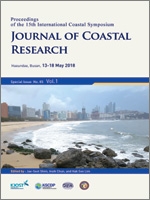Valentim, M.M.; Monteiro, S.M., and Rollnic, M., 2018. The influence of seasonality on haline zones in an Amazonian estuary. In: Shim, J.-S.; Chun, I., and Lim, H.S. (eds.), Proceedings from the International Coastal Symposium (ICS) 2018 (Busan, Republic of Korea). Journal of Coastal Research, Special Issue No. 85, pp. 76–80. Coconut Creek (Florida), ISSN 0749-0208.
This study relates salinity fluctuations throughout Mojuim estuary, dominated by macrotides and situated in the humid tropical region between the Pará River mouth and the Atlantic ocean (−0.72° and −48.00°), Northeastern Pará, Brazil. Water salinity in situ were measured, on the surface and at the bottom, with a multiparameter probe (Horiba U-50) for six months, corresponding to the intermediate season (July and August, 2016), dry season (November and December, 2016), and rainy season (January and February, 2017) during spring tide. Sampling stations comprehended 50 km throughout the estuary and were divided in five 10-km sectors. The sectors were classified according to the Venice System. Significant variations salinity (p>0.5) in water column were not observed, as it is a well-mixed estuary. During rainy season, were observed the lowest mean salinity (8.5±0.8 PSU), which increased to 15.99±0.37 PSU during the intermediate season, and to 22.38±0.61 PSU during dry season. Saline intrusion reached sector 5 (50 km upstream of the mouth) during dry season and was restricted to sector 3 (30 km) during rainy season. The latter showed the highest variation in haline zones in all seasons, and they varied from oligohaline during rainy season, to mesohaline during intermediate season, and polyhaline during dry season. During rainy and intermediate seasons, river domain limits tidal progression, and it is why sector 5 shows no haline variations, remaining as a freshwater zone, as opposed to dry season, when this sector shows a oligohaline zone, due to the higher tide reach and to the higher dispersion of salts in the estuary. These haline limits might vary interannually, which indicates the influence of climatological anomalies on estuary dynamics over the last years.





